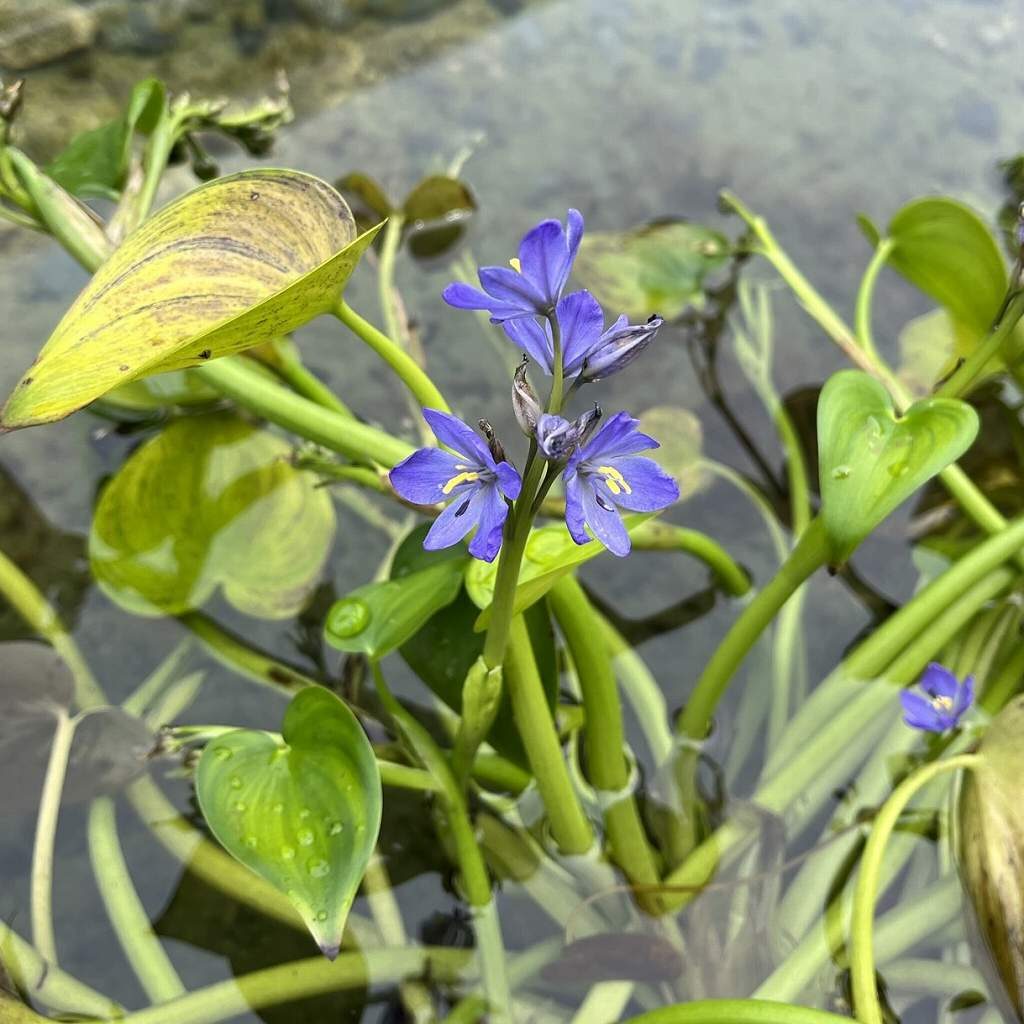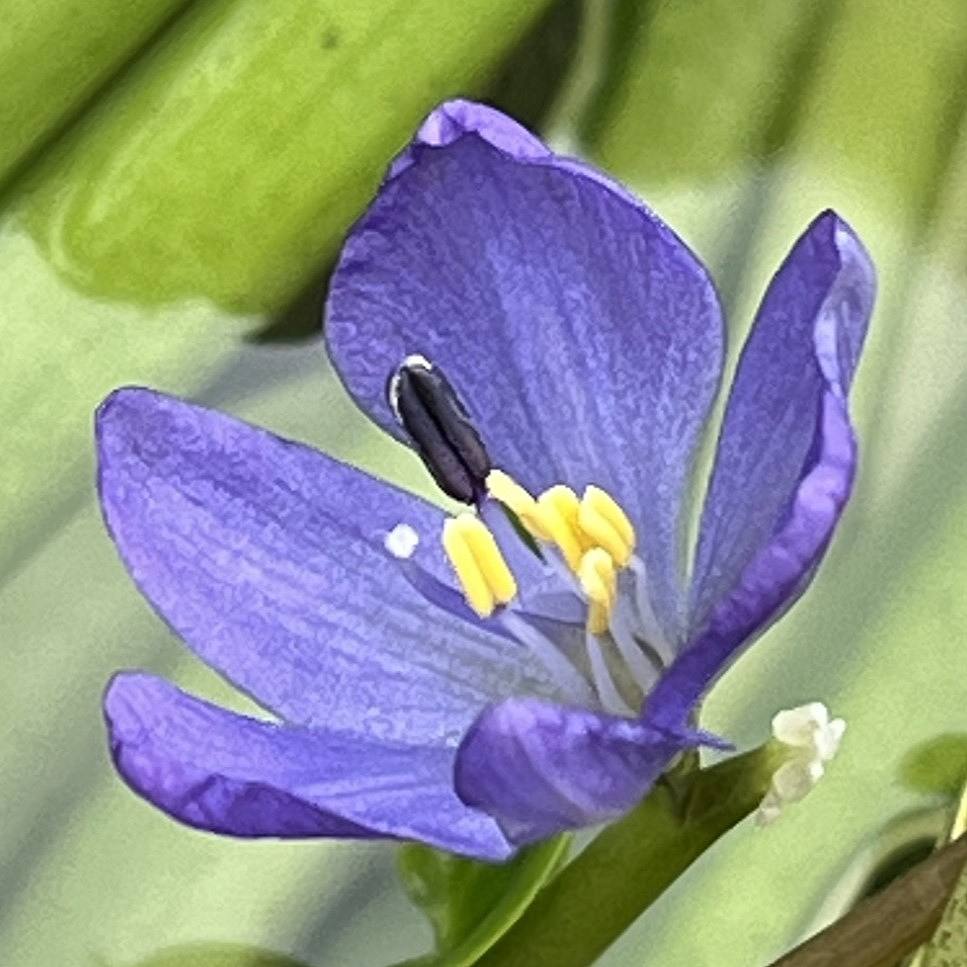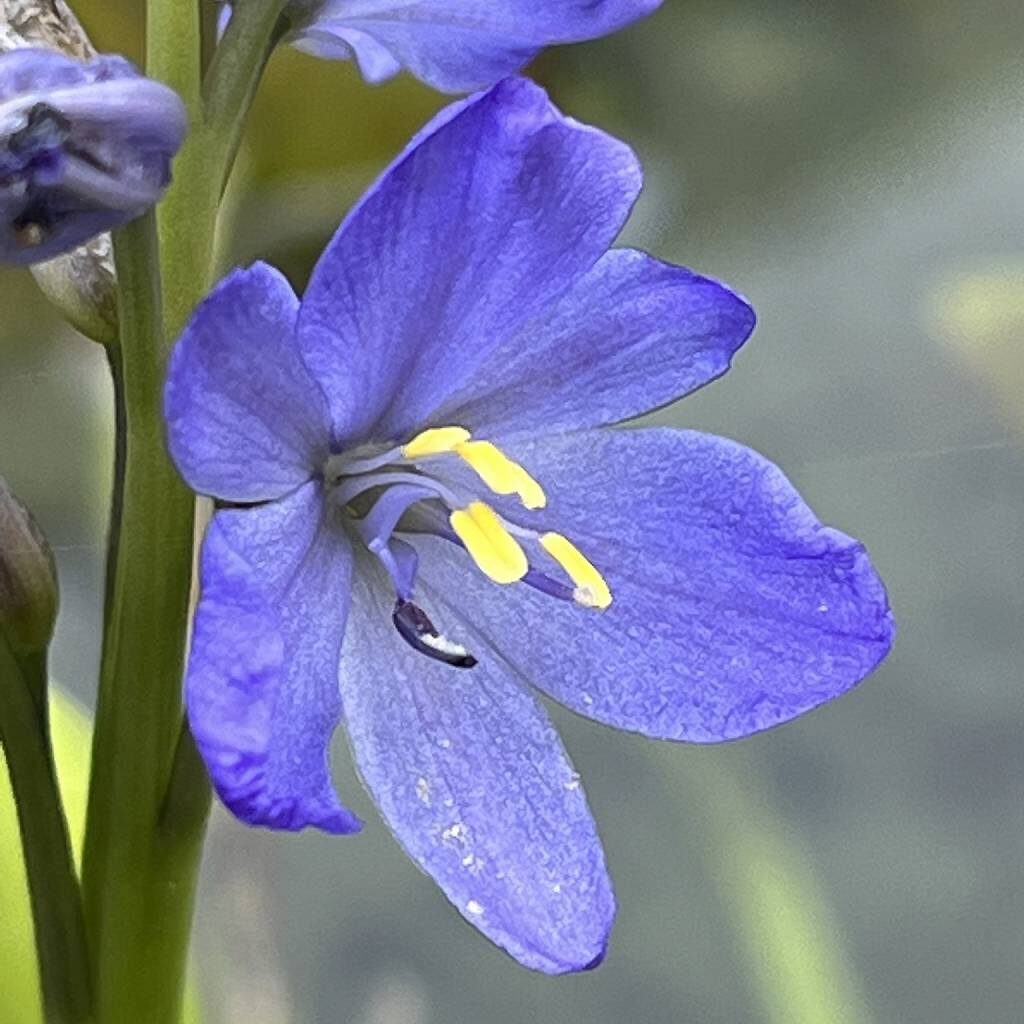ミズアオイは水上に花茎を立ち上げ、朝方に咲いて夕方に萎む1日花。花は雄しべ5本が上に伸び、1本が下に伸び、雌しべが下に伸びます。
Heartleaf False Pickerelweed raises the flower stalk above the water, and it blooms in the morning and wilts in the evening. The flower has five stamens extending upward, one extending downward, and a pistil extending downward.
【仮名】ミズアオイ
【和名】水葵
【英名】Heartleaf False Pickerelweed
【学名】Monochoria korsakowii
【誕生】08/ 29
【開花】08, 09, 10月
【花色】Violet



ミズアオイ
ミズアオイの昔
ミズアオイはミズアオイ科の1年草。日本では北海道から本州、四国、九州まで、国外ではロシア、朝鮮半島、中国に分布し、湖沼、水路、水田などで自生しています。昔は若い芽や葉が汁の具や和え物などで食用。漢方では生薬「雨久花」となり、高熱や喘息などに用いられました。
ミズアオイの葉
ミズアオイは根茎が地を這い、茎や葉柄が柔らかい多孔質。葉は葉柄が長く、葉身が厚く、光沢があります。名前の由来も茎や葉柄が水中や水上に伸び、葉がハート形でウマノスズクサ科の「双葉葵」や「寒葵」に似ているから。古くから「菜葱」「水葱」と呼ばれて親しまれました。
ミズアオイの雄しべ
ミズアオイは水上に花茎を立ち上げ、朝方に咲いて夕方に萎む、花被片6枚の1日花。雄しべは6本ですが、そのうち5本が黄色の葯で上に伸び、残り1本が紫色の葯で右下か左下に伸びます。この独特な雄しべの形状により、ラテン語の属名モノコリアは「1つ離れて」という意味。
ミズアオイの雌しべ
ミズアオイの雌しべも下に伸びますが、下に伸びる雄しべが右なら左に、左なら右に伸びます。これは訪花昆虫が下に伸びる雄しべを足場にして、上に伸びる雄しべの花粉を背中の右側か左側で受け、その反対側に着いた花粉を雌しべに渡すため。遺伝子の遠い交配を促す仕組みです。
ミズアオイの実
ミズアオイの実は蒴果ですが、熟してもすぐには種子を散らしません。果実は熟すと花茎が倒れ、水に浸かると離れて漂い、親株から遠いところで種子を放出。種子もすぐには発芽しません。ヨシのような背丈の高い植物が繁茂しているうちは土中に潜み、それらが衰退してから発芽。
ミズアオイの今
ミズアオイの近縁種「小菜葱」は草丈も花も小さいものの、姿形が水葵にそっくり。しかし、稲作の強害雑草である小菜葱は除草剤で駆逐されました。ところが、その除草剤が水葵にも効いてしまい、水田の基盤整備も重なって衰退。水葵は今、各地で絶滅危惧種に指定されています。
Heartleaf False Pickerelweed
The past of Heartleaf False Pickerelweed
Heartleaf False Pickerelweed is an annual plant belonging to the Pontederiaceae family. In Japan, it is distributed from Hokkaido to Honshu, Shikoku, and Kyushu, and overseas, it is distributed in Russia, the Korean Peninsula, and China. In the past, the young buds and leaves were edible as ingredients for soups and marinated dishes. In Kampo medicine, it became a crude drug “long rain flower” and was used for high fever and asthma.
Leaves of Heartleaf False Pickerelweed
The rhizome of Heartleaf False Pickerelweed crawls on the ground, and the stem and petiole are soft and porous. The leaves have long petioles, thick leaf blades, and are glossy. The origin of the Japanese name “Water Asarum” is also because the stems and petioles extend in and above the water, and the leaves are heart-shaped, resembling “Asarum caulescens” and “Asarum nipponicum” of the Aristolochiaceae family. Since ancient times, it has been popularly called “green onion” or “water onion”.
Stamens of Heartleaf False Pickerelweed
Heartleaf False Pickerelweed raises the flower stalk above the water, blooms in the morning and wilts in the evening. There are 6 stamens, 5 of which have yellow anthers that extend upward, and the remaining one has purple anthers that extend to the lower right or lower left. Because of this unique stamen shape, the Latin genus name Monochoria means “one apart”.
Pistil of Heartleaf False Pickerelweed
The pistil of Heartleaf False Pickerelweed also extends downward, but if the stamen extending downward extends to the left, it extends to the right. This is because flower-visiting insects use the stamens that grow downwards as a foothold, receive the pollen from the stamens that grow upwards on the right or left side of the back, and pass the pollen on the opposite side to the pistil. It is a mechanism that promotes distant mating of genes.
Fruit pf Heartleaf False Pickerelweed
The fruit of Heartleaf False Pickerelweed is a capsule, but it does not disperse the seeds immediately after ripening. The flower stalk falls down when the fruit ripens, and the fruit drifts away from the parent plant, where it releases the seed. Seeds also do not germinate quickly. It can’t grow while tall plants such as reeds are thriving, so it hides in the soil and germinate after they decline.
Present of Heartleaf False Pickerelweed
A close relative of Heartleaf False Pickerelweed “Monochoria vaginalis” has a small plant height and flowers, but looks just like Heartleaf False Pickerelweed. Monochoria vaginalis was a harmful weed for paddy rice production, so it was exterminated with herbicides. However, that herbicide was also effective against Heartleaf False Pickerelweed, and Infrastructure development of paddy fields also made it decline. It is now designated as an endangered species in various places.


